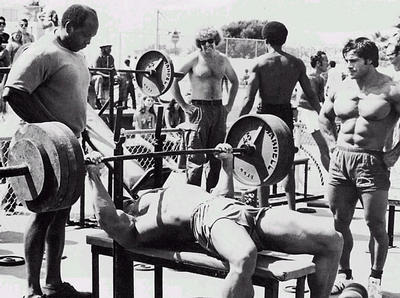Training for maximum power requires you to recruit the high-threshold motor units. To recruit them, you must lift maximal loads (>85% of 1RM) or you must lift submaximal loads (50-75% of 1RM) with high acceleration so the actual lifting velocity…
The two Olympic lifts, the snatch and clean and jerk, are awesome exercises to build muscle and power. However, both lifts are very technical and most people don’t have the strength, coordination, and mobility to do them correctly. That’s why…
I frequently talk about the importance of a well-tuned nervous system to activate and stimulate your muscle fibers. Indeed, the neural processes involved in muscle contraction start in your brain, travel down your spinal cord, and feed information to the…
Imagine this scenario. You’re sitting in the audience at a strength and conditioning conference, there to learn a thing or two about building bigger, stronger muscles, and the speaker calls you up to the podium.
The speaker has a barbell onstage with a stack of plates next to it. He tells you that you’re going to test your maximum strength for the deadlift in front of the audience.
You’re a little nervous, but you get yourself onstage and go through a typical warm-up that consists of a handful of sets with progressively heavier weights. You’re not a powerlifter, just a regular gym rat, so you know the pull isn’t going to impress anyone in the powerlifting game. But you don’t care. You’re in front of a couple hundred people and this is your time to shine.
After a few minutes you’ve got the weight dialed in. With all the effort you can muster you manage to pull 350 pounds. This load, clearly evident to yourself and anyone watching, is your true one repetition maximum. Five more pounds and you would’ve failed.
“Not bad,” says the speaker. “And guess what? Today is your lucky day. Let’s see if you can pull more weight with motivation from some dead Presidents.”
The speaker reaches behind the podium and pulls out a briefcase, opens it, and shows you a million bucks – cash. This isn’t that snooze-fest television, Deal or No Deal – this is the real deal and you know it.
“All you have to do is pull 20 more pounds and the cash is yours,” the speaker says. He throws another 10-pound plate on each side of the 350-pound barbell, now making it 370 pounds, and smiles.
Think you could pull that extra 20 pounds for a million bucks? Of course you could!
With most things in life, though, reward doesn’t come without risk. This contest is no exception. You just took a million from the speaker and he wants to up the ante in order to get it back. I mean, really up the ante.
So he reaches behind the podium and pulls out a chainsaw. Like a scene straight out of The Texas Chainsaw Massacre, he fires up the gas-filled tree killer, hoists it in the air, and swings it around while belting out a hellacious howl. You’re not sure what’s on the line, but you’re damn sure whatever it is ain’t good.
You were right.
The speaker looks you dead in the eyes, and with a tone that makes Johnny Cash sound like Alvin the Chipmunk, he passes on this little gem.
“You must add another 20 pounds to your deadlift or I’m going to cut off both of your legs.”
You and your legs don’t doubt his dedication to the chainsaw swinging craft, so you decide it’s best to proceed. After all, that half-inch you added to your calves didn’t come easy, and your vastus medialis muscles have been looking pretty impressive in those board shorts your girlfriend bought you at Patagonia.
The speaker adds 20 more pounds to the bar, making it 40 pounds heavier than when you started, and then gives you a nod while gripping the chainsaw with the most ominous look you’ve ever seen.
Now, here’s my question: Do you think you could pull those extra 20 pounds if your God-given wheels were on the line?
I’d be willing to bet both my legs, my arms, and my autographed Miley Cyrus poster that you could.
Why? Read on.
Motor unit recruitment is a seemingly straightforward process as I covered in part 1 and part 2 of this series. But like anything with the human body, eventually a simple explanation becomes, well, not so simple once you look at…
In my first installment of this series, I explained how the incredibly important size principle works. It’s crucial to understand that information, so if you haven’t checked it out you can do so by clicking here. To recap, all movements…
 Understanding the science of motor units is absolutely essential for getting results, whether you want to gain muscle, build strength, or torch body fat. Building muscle fast requires you to recruit, and fatigue, all your motor units so they’ll grow. To reach elite levels of strength you must train your body to tap into the biggest, strongest motor units as fast as possible. And to burn fat, it’s essential to boost the metabolic cost of the exercises in your workouts as high as possible. How do you skyrocket the metabolic cost? You guessed it, by recruiting more motor units.
Understanding the science of motor units is absolutely essential for getting results, whether you want to gain muscle, build strength, or torch body fat. Building muscle fast requires you to recruit, and fatigue, all your motor units so they’ll grow. To reach elite levels of strength you must train your body to tap into the biggest, strongest motor units as fast as possible. And to burn fat, it’s essential to boost the metabolic cost of the exercises in your workouts as high as possible. How do you skyrocket the metabolic cost? You guessed it, by recruiting more motor units.
Take a close look at the picture above. The yellow area is your brain, spinal cord, and a bunch of nerves that travel throughout your body. It’s the output from this electrical mainframe that controls your muscles.
That’s why, over the next week, I’m going to cover everything you need to know about the science of motor unit recruitment, along with some intriguing new research that could change the way we think about motor units. So let’s start at the beginning.
“What the heck is a motor unit, anyway?” That’s probably a question you’ve asked yourself once or twice. As defined by my grad school bible, Principles of Neural Science: “The axon and the muscle fibers it innervates constitute a motor unit.”
Clear as mud, eh? In layman’s terms, the motor unit is a collection of muscle fibers along with the nerve that tells those muscle fibers to contract. Each group of muscles is innervated by only one nerve. A nerve can can talk to 100 muscle fibers (small, eye muscles), or thousands of muscle fibers (large, hamstrings muscles) or somewhere in between.
Before you curl a dumbbell an electrical signal starts in your brain and travels down your spinal cord to the lower cervical region where it activates a different nerve that goes out to your biceps. This nerve that exits your spinal cord and reaches your biceps is a motor neuron. (“Neuron,” by the way, is just another name for “nerve.”) The activated motor neuron releases the neurotransmitter, acetylcholine, which attaches to receptors on your muscles that create a cascade of events that contracts your biceps. (Of course, this all happens in fractions of a second.)
 The bench press is the most popular strength-training exercise in the U.S., but most people don’t know how to do it correctly. I’ll give you full disclosure and admit that I’m not a huge fan of the exercise.
The bench press is the most popular strength-training exercise in the U.S., but most people don’t know how to do it correctly. I’ll give you full disclosure and admit that I’m not a huge fan of the exercise.
The reason is not because the bench press is “bad” per se. It can add strength and size to your upper body pushing muscles and this, in turn, will carryover to many sports.
The problem I have with the bench press is this: out of all the strength-building exercises it’s one of the most common exercises that guys screw up. When you bench press with poor form it can really wreak havoc on your shoulders and elbows. That’s why it’s imperative to get the technique right.
Luckily, Jim “Smitty” Smith has put together a comprehensive list to ensure that you’re pressing with perfect form. With this information you’ll build awesome upper body power while saving your joints.
A big deadlift is essential for building full-body mass and strength. So today I’m passing on some awesome tips from strongman and body transformation expert, Jim “Smitty” Smith. Smitty knows how to build some serious muscle and strength. He’s spent…
 In part 1 I outlined three of the reasons why full body training is so effective, along with cool sample workouts. Now I’m going to show you how to design a total body program with two specific goals in mind: muscle growth or maximal strength gain. I don’t know any natural guy who thinks he’s too big and strong.
In part 1 I outlined three of the reasons why full body training is so effective, along with cool sample workouts. Now I’m going to show you how to design a total body program with two specific goals in mind: muscle growth or maximal strength gain. I don’t know any natural guy who thinks he’s too big and strong.
Before I get to that, let me quickly touch on one reason why there’s so much controversy surrounding the body part split vs. full body training debate.
You see, it’s common for people to look for training advice from the biggest guy in the room. That’s why every guy who’s looking to build muscle wants to know how Dorian Yates, Ronnie Coleman, or Jay Cutler trains. That’s exactly what I wanted to know back in my teens. And many bodybuilders with massive amounts of muscle follow some type of body part split. Yet, I’m telling you that a full body training program is the best way to build muscle.
Why the discrepancy?
